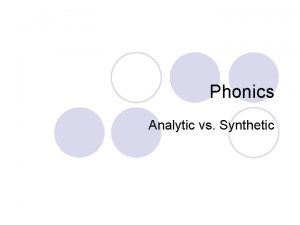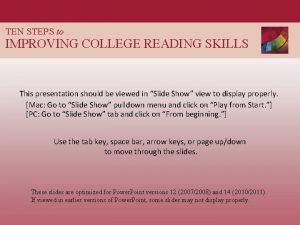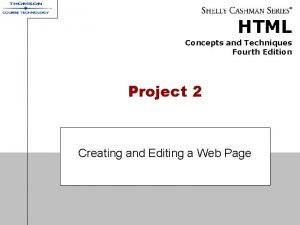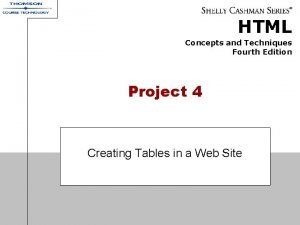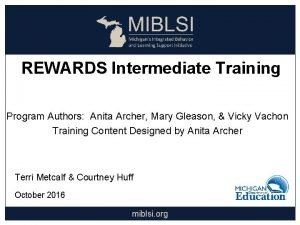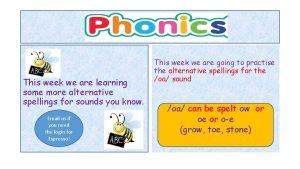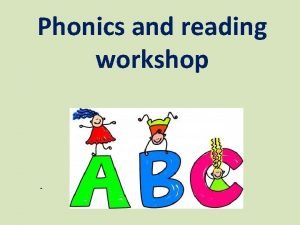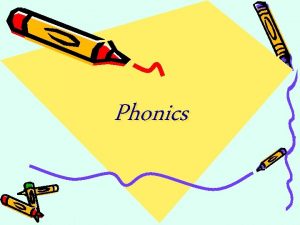GROUNDWORK FOR COLLEGE READING WITH PHONICS Fourth Edition

















- Slides: 17

GROUNDWORK FOR COLLEGE READING WITH PHONICS Fourth Edition John Langan © 2008 Townsend Press

Part II, Chapter Five: Supporting Details THIS CHAPTER IN A NUTSHELL • Supporting details are the evidence — such as reasons or examples — that backs up main ideas. Those details help you understand main ideas. • Outlines and maps can show you a main idea and its major and minor supporting details at a glance.

SUPPORTING DETAILS Cartoon copyright 2006 by Randy Glasbergen. www. glasbergen. com • What is the dog’s main idea, or point? • What is his support for his point?

SUPPORTING DETAILS Cartoon copyright 2006 by Randy Glasbergen. www. glasbergen. com • What is the dog’s main idea, or point? He has had a horrible day and is stressed out. • What is his support for his point? He gives three examples: lost ball, warm water dish, and broken squeaker toy.

WHAT ARE SUPPORTING DETAILS? Supporting details are reasons, examples, facts, or other kinds of evidence that explain a main idea, or point.

WHAT ARE SUPPORTING DETAILS? Which of these three statements is the main idea? Which statements are supporting details? A. People who do not exercise regularly after age 30 suffer the consequences. B. Inactive people lose nearly one pound of muscle each year after age 30. C. After age 30, inactive people lose about 5 percent of their strength every decade.

WHAT ARE SUPPORTING DETAILS? Which of these three statements is the main idea? Which statements are supporting details? A. People who do not exercise regularly after age 30 suffer the consequences. Main idea B. Inactive people lose nearly one pound of muscle each year after age 30. Supporting detail C. After age 30, inactive people lose about 5 percent of their strength every decade. Supporting detail

OUTLINING Outlines begin with the main idea, followed by supporting details. • Major details explain and develop the main idea. • Minor details help fill out the major details and make them clear.

OUTLINING Here is part of the paragraph on basic fears, followed by an outline of it. Certain basic fears are part of our lives. For one thing, we fear being disrespected. Bullies play on this fear. They cruelly tease their victims and take away their self-respect. And we feel hurt and disrespected when someone doesn’t return our phone calls or walks past us without saying hello. Another of our deepest fears is being alone. No matter how tough we act, we know that the poet who wrote “No man island” was telling the truth. We need each other. Not having other people in our lives makes us feel empty inside. Main idea: Certain basic fears are part of our lives. Major detail: 1. Being disrespected Minor details: a. Bullies tease us. b. We’re hurt when phone calls are not returned. Major detail: 2. Being alone Minor details: a. “No man island. ” b. Not having other people in our lives makes us feel empty.

OUTLINING Outlining Tips Tip 1: Look for words that tell you a list of details is coming: several kinds of a number of four steps various causes a series of among the results a few reasons three factors several advantages Example Certain basic fears are part of our lives. For one thing, we fear being disrespected. Bullies play on this fear. They cruelly tease their victims and take away their self-respect. And we feel hurt and disrespected when someone doesn’t return our phone calls or walks past us without saying hello. Another of our deepest fears is being alone. No matter how tough we act, we know that the poet who wrote “No man island” was telling the truth. We need each other. Not having other people in our lives makes us feel empty inside.

OUTLINING Outlining Tips Tip 2: Look for words that signal major details. These words are called addition words: one first of all for one thing to begin with another second also in addition next moreover furthermore last of all finally Examples Certain basic fears are part of our lives. For one thing, we fear being disrespected. Bullies play on this fear. They cruelly tease their victims and take away their self-respect. And we feel hurt and disrespected when someone doesn’t return our phone calls or walks past us without saying hello. Another of our deepest fears is being alone. No matter how tough we act, we know that the poet who wrote “No man island” was telling the truth. We need each other. Not having other people in our lives makes us feel empty inside.

MAPPING Maps, or diagrams, are visual outlines in which circles, boxes, or other shapes show the relationship between main ideas and supporting details.

MAPPING Below is a map of the paragraph on basic fears. Certain basic fears are part of our lives. For one thing, we fear being disrespected. Bullies play on this fear. They cruelly tease their victims and take away their self-respect. And we feel hurt and disrespected when someone doesn’t return our phone calls or walks past us without saying hello. Another of our deepest fears is being alone. No matter how tough we act, we know that the poet who wrote “No man island” was telling the truth. We need each other. Not having other people in our lives makes us feel empty inside. Certain basic fears are part of our lives. Being disrespected Bullies tease us. We’re hurt when phone calls aren’t returned or people don’t say hello. Being alone “No man island. ” Not having other people in our lives makes us feel empty inside.

MAPPING Read the following paragraph. Notice the list words and the words that signal the three major details. In our busy lives, there are different steps we take to save time. First, we use modern inventions to help us do more in less time. For instance, we use a microwave oven to cook a baked potato instead of baking it in the oven. Or we use the self-checkout option at the grocery store rather than waiting for a cashier. We also save time by doing more than one thing at a time. For example, a student may finish writing a paper while eating breakfast. Or we may take a shower and brush our teeth at the same time. Finally, of course, we may simply rush. We may save time simply by gulping a meal or running to catch to a bus. 1. What words in the first sentence tell you that a list will follow? 2. What word signals the first major detail? 3. What word signals the second major detail? 4. What word signals the third major detail?

MAPPING Read the following paragraph. Notice the list words and the words that signal the three major details. In our busy lives, there are different steps we take to save time. First, we use modern inventions to help us do more in less time. For instance, we use a microwave oven to cook a baked potato instead of baking it in the oven. Or we use the self-checkout option at the grocery store rather than waiting for a cashier. We also save time by doing more than one thing at a time. For example, a student may finish writing a paper while eating breakfast. Or we may take a shower and brush our teeth at the same time. Finally, of course, we may simply rush. We may save time simply by gulping a meal or running to catch to a bus. 1. What words in the first sentence tell you that a list will follow? different steps 2. What word signals the first major detail? First 3. What word signals the second major detail? also 4. What word signals the third major detail? Finally

MAPPING: An Example In our busy lives, there are different steps we take to save time. First, we use modern inventions to help us do more in less time. For instance, we use a microwave oven to cook a baked potato instead of baking it in the oven. Or we use the self-checkout option at the grocery store rather than waiting for a cashier. We also save time by doing more than one thing at a time. For example, a student may finish writing a paper while eating breakfast. Or we may take a shower and brush our teeth at the same time. Finally, of course, we may simply rush. We may save time simply by gulping a meal or running to catch to a bus. In our busy lives, there are different steps we take to save time. Use modern inventions Microwave Selfcheckout option Do more than one thing at a time Finish paper while eating breakfast Shower and brush our teeth Rush Gulp a meal Run to catch a bus

CHAPTER REVIEW In this chapter, you learned the following: • Supporting details go hand in hand with main ideas. They provide the added information you need to make sense of a main idea. • List words and addition words can help you to find major and minor supporting details. • Outlining and mapping are useful note-taking strategies. • Outlines and maps, or diagrams, show the relationship between the main idea, major details, and minor details of a passage. The next chapter—Chapter 6—will deepen your understanding of the relationship between main ideas and supporting details.
 Major and minor supporting details
Major and minor supporting details Main idea
Main idea Groundwork for college reading
Groundwork for college reading Learn composition of various synthetic bases
Learn composition of various synthetic bases Rwd html
Rwd html 10 steps to improving college reading skills
10 steps to improving college reading skills Project 2 fourth edition
Project 2 fourth edition Pathways algebra 2 answer key
Pathways algebra 2 answer key Ethics in information technology fourth edition
Ethics in information technology fourth edition Ethics in information technology fourth edition
Ethics in information technology fourth edition Vertical line code in html
Vertical line code in html Discrete mathematics with applications fourth edition
Discrete mathematics with applications fourth edition Expert systems: principles and programming, fourth edition
Expert systems: principles and programming, fourth edition Phonics for reading anita archer
Phonics for reading anita archer Reading robot phonics play
Reading robot phonics play Pre reading while reading and post reading activities
Pre reading while reading and post reading activities The fourth foundation pay cash for college
The fourth foundation pay cash for college Mis chapter 6
Mis chapter 6



